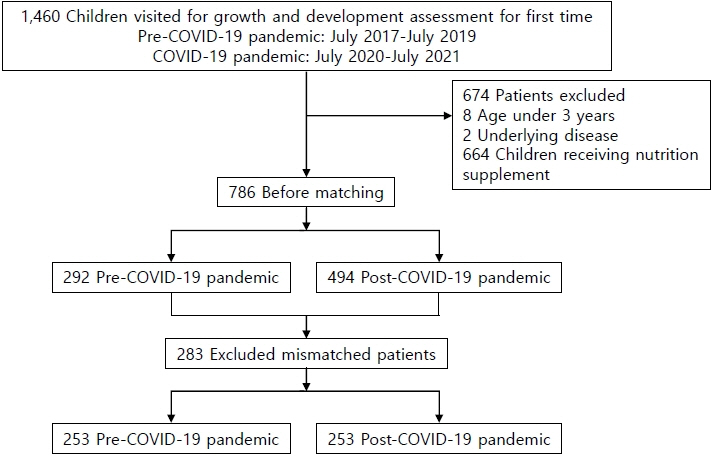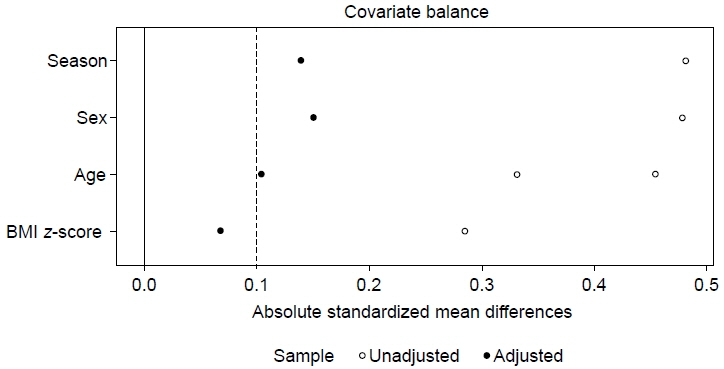Ann Pediatr Endocrinol Metab.
2024 Aug;29(4):220-226. 10.6065/apem.2346196.098.
Effects of the COVID-19 pandemic on serum vitamin D concentration in Korean children
- Affiliations
-
- 1Department of Pediatrics, Hanyang University Seoul Hospital, Korea
- 2Department of Pediatrics, Hanyang University Guri Hospital, Korea
- 3Department of Pediatrics, College of Medicine, Hanyang University, Korea
- KMID: 2559449
- DOI: http://doi.org/10.6065/apem.2346196.098
Abstract
- Purpose
Social distancing policies and school closures in South Korea induced by coronavirus disease 2019 have raised concerns about a lower chance of exposure to sunlight in children and adolescents. This study investigates changes in the vitamin D status of children and adolescents following the pandemic.
Methods
This retrospective study includes healthy children aged 3–18 years who visited Hanyang University Hospitals in Seoul or Guri during pre-coronavirus disease 2019 (COVID-19) and post-COVID-19 pandemic periods. August 2017 to July 2019 is defined as the pre-COVID-19 pandemic period, while the period from July 2020 to July 2021 is defined as post-COVID-19 or "during the pandemic." Propensity scores were used to match the prepandemic and pandemic groups 1:1 based on age, sex, season of blood collection, and body mass index z-score to compare vitamin D status among subjects.
Results
Among 786 eligible children, 506 were matched using propensity scores. There were no significant differences in mean serum 25-hydroxyvitamin D (25(OH) D) levels (20.1±6.5 ng/mL vs. 19.9±6.3 ng/mL, P>0.05) or vitamin D deficiency rates (53.0% vs. 54.9%, P>0.05) between the prepandemic and pandemic groups. Seasonal analysis revealed lower mean serum 25(OH)D levels during the pandemic in winter/spring seasons in comparison to these levels in subjects in prepandemic winter/spring seasons (19.1±3.8 ng/mL vs. 17.2±3.7 ng/mL, P=0.006).
Conclusion
During the COVID-19 pandemic, Korean children and adolescents showed similar serum 25(OH)D levels and vitamin D status to the prepandemic period, with a significant decrease in these measures observed in winter/spring seasons only. Prolonged confinement, such as in pandemic circumstances, underscores the need for vigilant monitoring of vitamin D status and supplementation, particularly in high-risk seasons.
Keyword
Figure
Reference
-
References
1. Shin YH, Shin HJ, Lee YJ. Vitamin D status and childhood health. Korean J Pediatr. 2013; 56:417–23.
Article2. Zurita-Cruz J, Fonseca-Tenorio J, Villasis-Keever M, LopezAlarcon M, Parra-Ortega I, Lopez-Martinez B, et al. Efficacy and safety of vitamin D supplementation in hospitalized COVID-19 pediatric patients: a randomized controlled trial. Front Pediatr. 2022; 10:943529.
Article3. Ismailova A, White JH. Vitamin D, infections and immunity. Rev Endocr Metab Disord. 2022; 23:265–77.
Article4. O’Neill CM, Kazantzidis A, Ryan MJ, Barber N, Sempos CT, Durazo-Arvizu RA, et al. Seasonal changes in vitamin D-effective UVB availability in Europe and associations with population serum 25-hydroxyvitamin D. Nutrients. 2016; 8:533.
Article5. Holick MF. The vitamin D deficiency pandemic: approaches for diagnosis, treatment and prevention. Rev Endocr Metab Disord. 2017; 18:153–65.
Article6. Dunton GF, Do B, Wang SD. Early effects of the COVID-19 pandemic on physical activity and sedentary behavior in children living in the U.S. BMC Public Health. 2020; 20:1351.
Article7. Ministry of Health and Welfare. COVID-19, changes in infectious disease response over the past 3 years [Internet]. Sejong (Korea): Ministry of Health and Welfare;[cited 2023 Jan 20]. Available from: https://www.mohw.go.kr/react/al/sal0301vw.jsp?PAR_MENU_ID=04&MENU_ID=0403&CONT_SEQ=374685&page=1.8. Neville RD, Lakes KD, Hopkins WG, Tarantino G, Draper CE, Beck R, et al. Global changes in child and adolescent physical activity during the COVID-19 pandemic: a systematic review and meta-analysis. JAMA Pediatr. 2022; 176:886–94.9. Kang HM, Jeong DC, Suh BK, Ahn MB. The impact of the coronavirus disease-2019 pandemic on childhood obesity and vitamin D status. J Korean Med Sci. 2021; 36:e21.
Article10. Beyazgül G, Bağ Ö, Yurtseven İ, Coşkunol F, Başer S, Çiçek D, et al. How vitamin D levels of children changed during COVID-19 pandemic: a comparison of prepandemic and pandemic periods. J Clin Res Pediatr Endocrinol. 2022; 14:188–95.11. Holick MF, Binkley NC, Bischoff-Ferrari HA, Gordon CM, Hanley DA, Heaney RP, et al. Evaluation, treatment, and prevention of vitamin D deficiency: an Endocrine Society Clinical Practice Guideline. J Clin Endocrinol Metab. 2011; 96:1911–30.
Article12. Mosca C, Colucci A, Savoia F, Cali C, Del Bene M, Ranucci G, et al. Vitamin D levels in the pre- and post-COVID-19 pandemic periods and related confinement at pediatric age. Nutrients. 2023; 15:2089.
Article13. Fiamenghi VI, Mello ED. Vitamin D deficiency in children and adolescents with obesity: a meta-analysis. J Pediatr (Rio J). 2021; 97:273–9.
Article14. Cheng S, Massaro JM, Fox CS, Larson MG, Keyes MJ, McCabe EL, et al. Adiposity, cardiometabolic risk, and vitamin D status: the Framingham Heart Study. Diabetes. 2010; 59:242–8.
Article15. Zakharova I, Klimov L, Kur yaninova V, Nikitina I, Malyavskaya S, Dolbnya S, et al. Vitamin D insufficiency in overweight and obese children and adolescents. Front Endocrinol (Lausanne). 2019; 10:103.
Article16. Wortsman J, Matsuoka LY, Chen TC, Lu Z, Holick MF. Decreased bioavailability of vitamin D in obesity. Am J Clin Nutr. 2000; 72:690–3.
Article17. Wierzbicka A, Oczkowicz M. Sex differences in vitamin D metabolism, serum levels and action. Br J Nutr. 2022; 128:2115–30.
Article18. Muscogiuri G, Barrea L, Somma CD, Laudisio D, Salzano C, Pugliese G, et al. Sex differences of vitamin D status across BMI classes: an observational prospective cohort study. Nutrients. 2019; 11:3034.
Article19. Boğa A. Evaluation of the vitamin D levels of children according to seasons, gender and age. Haydarpasa Numune Med J. 2021; 61:372–6.
Article20. Kang S, Seo MY, Kim SH, Park MJ. Changes in lifestyle and obesity during the COVID-19 pandemic in Korean adolescents: based on the Korea Youth Risk Behavior Survey 2019 and 2020. Ann Pediatr Endocrinol Metab. 2022; 27:281–8.
Article21. Knapp EA, Dong Y, Dunlop AL, Aschner JL, Stanford JB, Hartert T, et al. Changes in BMI during the COVID-19 pandemic. Pediatrics. 2022; 150:e2022056552.
Article22. Lee A, Kim SH, Nam CM, Kim YJ, Joo SH, Lee KR. Prevalence of vitamin D deficiency and insufficiency in Korean children and adolescents and associated factors. Lab Med Online. 2016; 6:70–8.
Article23. Won JW, Jung SK, Jung IA, Lee Y. Seasonal changes in vitamin D levels of healthy children in mid-latitude, Asian urban area. Pediatr Gastroenterol Hepatol Nutr. 2021; 24:207–17.
Article24. Ha J, Lee J, Choi S, Park S. COVID-19 waves and their characteristics in the Seoul metropolitan area (Jan 20, 2020- Aug 31, 2022). Public Health Wkly Rep. 2023; 16:111–36.25. Ministry of Education. COVID-19 response white paper [Internet]. Seoul (Korea): Ministry of Education;2022. [cited 2023 Jan 20]. Available from: https://www.moe.go.kr/boardCnts/viewRenew.do?boardID=294&lev=0&statusYN=W&s=moe&m=020402&opType=N&boardSeq=91497.26. Bener A, Al-Ali M, Hoffmann GF. Vitamin D deficiency in healthy children in a sunny country: associated factors. Int J Food Sci Nutr. 2009; 60 Suppl 5:60–70.
Article
- Full Text Links
- Actions
-
Cited
- CITED
-
- Close
- Share
- Similar articles
-
- Digital Media Usage Trends Among Children Aged 8–11 Years Before and After the COVID-19
- The Management of Thyroid Disease in COVID-19 Pandemic
- The Effects of COVID-19 Pandemic on the Mental Health of the General Public and Children and Adolescents and Supporting Measures
- Psychological Effects of the Coronavirus Disease 2019 Pandemic
- Assessment and Management of Dysphagia during the COVID-19 Pandemic



